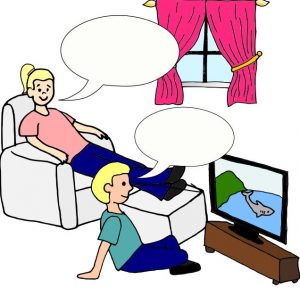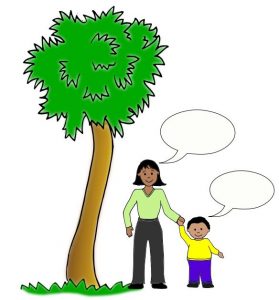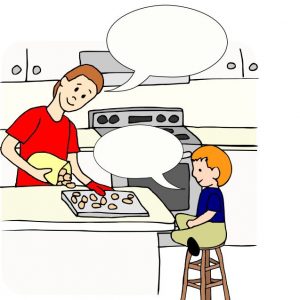
It’s winter! When the weather is cold and rainy, it can be hard to think of ways to have fun outside. Here are ten ideas of fun outdoor activities for those cold or rainy days that have lots of opportunity for using receptive, expressive, and social communication skills. So, dress for the weather and get outside!
- Outdoor Scavenger Hunt
Before heading out, create a list of things to find that match the season and weather (you can use pictures or drawings for your list for the non-readers. You can assign roles (e.g., navigator, hunter, recorder) to practice listening, speaking, and cooperation. List ideas might include pinecones, icicles, or footprints if it’s snowy; or worms, waterspouts, or raindrops on a flower if it’s rainy. - Winter Obstacle Course
Set up a simple obstacle course, like walking on a “balance beam” (a log or bench work well), jumping over rocks or snow mounds, splashing through a puddle, or crawling under low tree branches. Players can take turns giving each other instructions for the route and kids can earn points for how many obstacles they remember, how quickly they complete the course, or how fun the participants rate that route. - Cold Weather Charades
Act out winter-related activities (like sledding, skiing, or shoveling snow). Kids guess the actions, practicing both expressive and interpretative communication skills. You could extend this activity so that people then act out something that could happen next, like winning a gold medal at the Olympics for a fast ski race. - Weather Reporter Role-Play
Pretend to be weather reporters covering a “storm.” Take turns as the reporter and camera operator. Practice making up news stories about what’s happening. You could think of “guests” to interview, like Mr. Squirrel, Windy the Wind, or Ms. Orca, to practice perspective-taking, acting, clear speaking, and using your imagination. Film the weather reports and watch them together after, reliving the fun! - Winter Survival Scenario Game
Pretend to be stranded in the snow and brainstorm survival strategies. Kids can discuss what they’ll need, negotiate how they will prioritize tasks (e.g., building a shelter, finding food), and come up with creative solutions to solve problems that arise. - Cold-Weather Role-Playing Adventure
Create a story-based game where kids play different characters in a chilly environment (e.g., Arctic Explorers, Animals in the Tundra, Treasure Hunters). Kids can talk about what they’d see, hear, smell, and feel in these roles and situations, what they’d wear, how they’d move, and adventures that might occur. - Puddle Reflection Exploration
 While out for a walk, look around for interesting reflections in puddles. You can look at the puddle from opposite sides or directions and describe what you see to each other (kind of like looking for different shapes in clouds in the summer!). If you each see different things, switch sides and try to see how both of your perspectives can be true, depending on your viewpoint.
While out for a walk, look around for interesting reflections in puddles. You can look at the puddle from opposite sides or directions and describe what you see to each other (kind of like looking for different shapes in clouds in the summer!). If you each see different things, switch sides and try to see how both of your perspectives can be true, depending on your viewpoint. - Fort Building Challenge
Use natural materials (sticks, leaves, rocks) or what you have around the house or yard to construct a “fort” that can withstand the rain. Tell each other your ideas and problem-solve as a team if something doesn’t work the first time. Make it a goal that the final fort includes at least one idea from everyone playing. - Group Storytelling in the Rain
Dress for the weather, then find a spot to sit or take a walk while taking turns contributing to a collaborative story. The setting can be inspired by the weather or a storybook, like “A Rainy Day Adventure.” This is more fun if everyone has a hot chocolate to enjoy while being storytellers together! - Tropical Island Beach Vacation
Some days it just might be TOO nasty out for much outdoor play. Escape the weather inside by pretending it’s summertime and you’re on a beach or tropical island! Ask everyone what they think of when they think of summer? What would they see? Hear? Feel? Taste? Smell? Kids can wear their bathing suits or summer clothes, lay out towels, put on sunglasses, and pretend to be at the beach. To burn some energy, try a take on “the floor is lava” and pretend to hop between islands (Pillows? Cushions?), avoiding the ocean and sharks (floor) below!
Have fun playing and communicating together, and stay warm and dry!
 As we are spending so much time at home, we are facing the dilemma of how to keep our children entertained.
As we are spending so much time at home, we are facing the dilemma of how to keep our children entertained. Your child’s teacher and school librarian always encourage reading books at home. Keep reading below or
Your child’s teacher and school librarian always encourage reading books at home. Keep reading below or  You can support your child’s language skills when playing inside on rainy days, or whenever your child needs to take a movement or brain break to play!
You can support your child’s language skills when playing inside on rainy days, or whenever your child needs to take a movement or brain break to play!  While keeping a safe physical distance from others, you can support your child’s language skills when playing outside.
While keeping a safe physical distance from others, you can support your child’s language skills when playing outside.  During this unprecented time of social distancing, many of us are eating at home with our families more than before. Cooking together is a wonderful way to work on language goals with your child! Narrate as you plan and cook together. This provides a language model for your child and is a great way to introduce new vocabulary and grammar. For example, “First I am mixing in the eggs, then I will mix in the milk”. Remember to speak in the first person instead of referring to yourself as Mommy/Daddy (e.g., use “I am mixing in the eggs.” instead of “Mommy is mixing in the eggs.”). Meals are also a great time to sit and practice language in a relaxed way.
During this unprecented time of social distancing, many of us are eating at home with our families more than before. Cooking together is a wonderful way to work on language goals with your child! Narrate as you plan and cook together. This provides a language model for your child and is a great way to introduce new vocabulary and grammar. For example, “First I am mixing in the eggs, then I will mix in the milk”. Remember to speak in the first person instead of referring to yourself as Mommy/Daddy (e.g., use “I am mixing in the eggs.” instead of “Mommy is mixing in the eggs.”). Meals are also a great time to sit and practice language in a relaxed way.